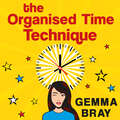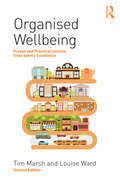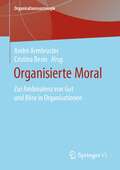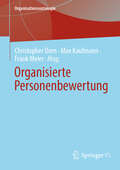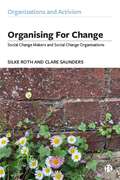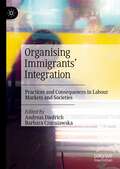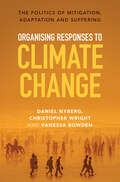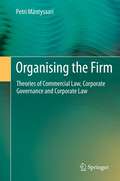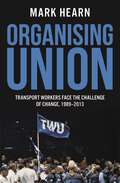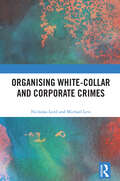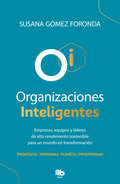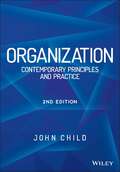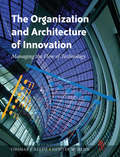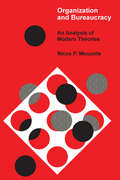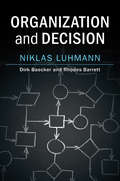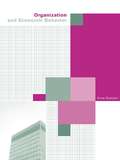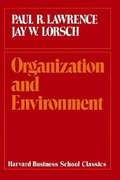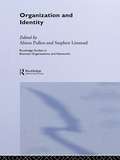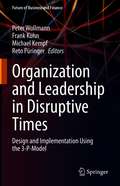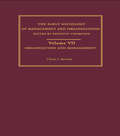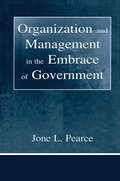- Table View
- List View
The Organised Time Technique: How to Get Your Life Running Like Clockwork
by Gemma BrayThe new life-changing technique from Gemma Bray - creator of The Organised Mum Method'Ingenious' Daily MailDo you ever get to the end of the day and feel like you've achieved nothing? Do you find it difficult to decide how to spend the small amount of free time you have? Do you ever wonder how some people seem to be able to fit everything in? If you're feeling overwhelmed by all the things you need to squeeze into your day, unproductive or stuck in a daily routine that isn't making you happy, The Organised Time Technique is for you. This is Gemma Bray's unique method for organising your day that will stop you from trying to do everything (and feeling like a failure when you can't), keep you focused on how you use the time you have available, help you play to your strengths and, most importantly, help you find time for the things that really matter. The Organised Time Technique provides the tools - and the headspace - you need to create a framework for your life that means you will always know where you are supposed to be, what you are supposed to be doing and when you are supposed to be doing it. By following the plan, you will not only get everything done, but also create space for the things that you really want to do, whether that's taking up a new hobby, reading a book, starting a side business or simply having a long, relaxing bath!Just as The Organised Mum Method helped you to feel on top of the housework, The Organised Time Technique will revolutionise the way you spend your day. In no time at all, you will go from feeling flustered to feeling fabulous.Are you ready?
Organised Wellbeing: Proven and Practical Lessons from Safety Excellence
by Tim Marsh Louise WardWellbeing is now at the top of almost everyone’s agenda and many technical books have been published on the topic. More than that, an ever-increasing number of organisations are understanding that getting wellbeing right is a win-win that can boost profits or simply make sustainability viable. Organised Wellbeing: Proven and Practical Lessons from Safety Excellence seeks to present, in a user-friendly way, all of the key wellbeing themes. It views these through the lessons learnt from safety excellence because, at present, UK safety is world class but, frankly, wellbeing seldom is. In any organisation, culture is even more important than strategy and tactics, and training is just the base of a process in which facilitation and embedding of key behaviours and mindsets is the essential element. Practical and coordinated processes, not initiatives, are required. This book, therefore, seeks to show how aspects of wellbeing, both organisational and personal, are inexorably interconnected. From an organisational perspective, approaches need to address the truth that ‘good work is good for you’. This book, also an individual guide to thriving with passion, compassion, humour and style, is essential reading for health and safety, occupational health and HR professionals at all levels. It is also highly recommended for all managers and staff who seek to maximise their potential and that of their colleagues.
Organisierte Moral: Zur Ambivalenz von Gut und Böse in Organisationen (Organisationssoziologie)
by Cristina Besio André ArmbrusterDer Band untersucht, inwieweit moralisch gutes oder schlechtes Handeln organisiert werden kann. Die Diskussion soziologischer Erklärungen des normativ Guten und Bösen in und von Organisationen beleuchtet den ambivalenten Zusammenhang von Moral und Organisation, da Organisationen sowohl für moralische Anliegen eintreten als auch moralisch-ethische Normen (teilweise sogar absichtlich) verletzen. Diese Ambivalenz adressiert der Band durch theoretisch-konzeptionelle Beiträge sowie durch empirische Studien. Der Band zeigt damit die große Varietät in der empirischen Beobachtbarkeit und der sozialwissenschaftlichen Analyse der Moralität von Organisationen – ohne selbst für oder gegen Moral zu argumentieren.
Organisierte Personenbewertung (Organisationssoziologie)
by Christopher Dorn Frank Meier Max KaufmannOrganisationen produzieren vielfältige Bewertungen von Personen. Der Band fragt nach Funktionen und Folgen organisierter Personenbewertung und danach, wie der Organisationskontext Personenbewertung prägt. Bewertungssoziologisch geht der Band der Vermutung nach, dass sich die Bewertung von Personen systematisch von der Bewertung anderer Objekte unterscheidet: Personen sind sakrale Objekte der Moderne, deren Bewertung sich als überaus heikel erweist, aber gerade in Organisationskontexten dennoch routinemäßig stattfindet. Personen sind darüber hinaus auch Subjekte, die sich auf ihre Bewertung einstellen, auf sie reagieren, an ihr mitwirken. Vor diesem Hintergrund fragen die Beiträge des Bandes, wie sich die Besonderheiten des Bewertungsobjekts Person auf organisierte Personenbewertungen auswirken, welche Aspekte von Personalität dabei berücksichtigt werden und welche Bedeutung Personenbewertungen für Organisationen haben.
Organising for Change: Social Change Makers and Social Change Organisations
by Silke Roth Clare SaundersBased on decades of research, this book explores global social change processes through the concepts of social change organisations (SCOs) and social change makers (SCMs) – the individuals working within and alongside SCOs. The book delves into a vast array of compelling social justice issues, from tackling inequality to championing human rights, bridging the realms of social movement and third sector research. Inspiring and empowering, this is essential reading for scholars, students, NGOs and activists alike.
Organising Immigrants' Integration: Practices and Consequences in Labour Markets and Societies
by Andreas Diedrich Barbara CzarniawskaThis collection of field studies offers novel insights into the issues of migration and integration of immigrants. The focus of the chapters is on actions, processes, and complexity of organising practices, in contrast to more policy-oriented works. The contributors address vital questions: How is the labour market integration of refugees and other immigrants being organised in practice? What ideas of integration give rise to, and are promoted by contemporary integration initiatives? And what are the effects of these integration initiatives – on immigrants’ lives, and on their labour market integration in terms of diversity, gender, and power relations? With contributions highlighting the importance of coordination and collaboration for the successful organising of integration, this book should be of interest to researchers and advanced students from the fields of management and organisation studies, public administration and management, migration and integration studies, sociology, cultural studies and science and technology studies. It should also interest professionals and policymakers working with integration who face the challenges described here in their daily work.
Organising Music
by Nic Beech Charlotte GilmoreOrganisational theorists have become increasingly interested in the creative industries, where practices that are commonplace are of particular interest to organisations in other sectors as they look for new ways to enhance performance. Focusing on the music industry, this book sets up a unique dialogue between leading organisational theorists and music professionals. Part I explores links between organisation theory and the creative industries literature, concentrating on practices of organising and knowledge mobilisation, followed by an in-depth discussion of key theoretical concepts by subject experts. Part II provides a diverse range of 'tales from the field', including examples from classical orchestras, folk, indie and punk. The concluding chapter examines the shared dialogue to reveal what practice in the musical field can learn from organisational theory, and vice versa. This innovative book will interest graduate students and researchers in the fields of organisation studies, music management and the creative industries.
Organising Responses to Climate Change: The Politics of Mitigation, Adaptation and Suffering
by Daniel Nyberg Christopher Wright Vanessa BowdenClimate change is the most important issue now facing humanity. As global temperatures increase, floods, fires and storms are becoming both more intense and frequent. People are suffering. And yet, emissions continue to rise. This book unpacks the activities of the key actors which have organised past and present climate responses – specifically, corporations, governments, and civil society organisations. Analysing three elements of climate change – mitigation, adaptation and suffering – the authors show how exponential growth of the capitalist system has allowed the fossil fuel industry to maintain its dominance. However, this hegemonic position is now coming under threat as new and innovative social movements have emerged, including the fossil fuel divestment movement, Fridays for Future, Extinction Rebellion and others. In exposing the inadequacies of current climate policies and pointing to the possibilities of new social and economic systems, this book highlights how the worst impacts of climate change can be avoided.
Organising the Firm: Theories of Commercial Law, Corporate Governance and Corporate Law
by Petri MäntysaariThe theoretical basis of commercial law, corporate governance law, and corporate law is still unsatisfactory. There essentially is no theory of commercial law, and existing theories of corporate governance and corporate law cannot explain the behaviour of firms or the contents of existing regulation. This book proposes a coordinated solution for all three areas. The starting point is that all three areas deal with the organisation of firms. Commercial law, corporate governance, and corporate law are therefore studied from the perspective of the firm rather than that of the judge or the investor. Changing the perspective makes it easier to formulate an "umbrella" theory of commercial law, and theories of corporate governance and corporate law as applications of the main theory. The book provides examples of how the proposed theories work by studying legal corporate governance tools and practices that increase the sustainability of the firm. Sustainability can be bolstered by making the governance model more self-enforcing and ensuring that it fosters innovation.
Organising Union: Transport Workers Face the Challenge of Change, 1989-2013
by Mark HearnBetween 1989 and 2013 every industry sector covered by the Transport Workers Union in New South Wales was utterly transformed by processes of globalisation and technological and market change. Large players consumed small firms; in turn, the bigger companies were often acquired by global players. The lesson that emerges from Organising Union is simple: the value of solidarity. In 2001 redundant Ansett workers were told they would never see their entitlements. In 2006 Tooheys owner-drivers were suddenly terminated by the company; the goodwill invested in their trucks and business was declared worthless. Ansett workers received almost all their entitlements—an unprecedented 95 cents in the dollar. The Tooheys drivers' jobs were saved, the value of their goodwill upheld. Those outcomes were possible only because of the solidarity of transport workers and the support of their union. No one else stood alongside the workers at Ansett and Tooheys as consistently and tenaciously as their own union. Organising Union explores the relationship between the union and key industry players, and between the union and governments. The TWU has often been at the centre of controversy: the turbulent 1989 union election punctuated by accusations of rorts and fist fights; the clashes with the Hawke and Keating governments over the Accord and enterprise bargaining, resulting in the TWU disaffiliating from the ACTU and a truck blockade of the Reserve Bank's Sydney headquarters; the devastating 2001 Ansett closure and the long industrial war with Qantas culminating in the dramatic 2011 airline shutdown; the struggle to achieve 'safe rates' for truckies against the resistance of employers and governments. In the face of these challenges solidarity—the strength of an organising union—has held the TWU together.
Organising White-Collar and Corporate Crimes
by Nicholas Lord Michael LeviThis book explores how we can re-constitute our approach to analysing and empirically investigating the organisation of white-collar and corporate crimes, with a view to building fuller theoretical and empirical accounts. The work demonstrates how knowledge can be produced and systematised within a conceptual and analytical framework concerned with understanding how such crimes are organised, why they are organised as they are, who gets involved in them as primary offenders and as facilitators, and the ‘real’ factors that shape these organisational dynamics over time in particular contexts and under varying conditions. In doing so, the book examines the distal (far-off) and proximal (close) social arrangements and relations that create and shape emergent white-collar crime opportunities and their structures. It also investigates the mechanisms, relationships, processes, and conditions that are necessary for the commission, or the unfolding, of white-collar crimes, or for their non-commission. How these are contingently connected to particular contexts is explored. The work also considers the people who collaborate, connect, and otherwise associate, whether ephemerally or for longer periods, in the pursuit of criminal goals and the actual or potential skills, expertise, and abilities of these people to accomplish or resist particular behaviours that are required of them. Finally, the book assesses the human, social, cultural, and material antecedents that enable white-collar crimes to flourish or fade. The work will be of particular interest to scholars theorising about and empirically investigating white-collar and corporate crimes, or seeking to understand empirical approaches to analysing such behaviours and other types of crime. It is primarily aimed at critical social scientists, including criminologists and sociologists, as well as socio-legal, business, economics, and political studies scholars. The work will also be of interest to practitioners and policymakers keen to learn more about how and why these crimes are organised as they are.
Organizaciones inteligentes
by Susana Gómez ForondaNuevos retos y nuevos modelos para una nueva era. Un libro imprescindible para directivos, mandos intermedios, consejeros y consultores comprometidos con emprender el camino del cambio inteligente. El mundo empresarial está enfrentándose a uno de los mayores desafíos de su historia. Las organizaciones que tendrán éxito en este siglo serán muy diferentes a las que lo tuvieron en el siglo XX. Por eso, es fundamental desarrollar un paradigma que responda de manera efectiva a los retos actuales y logre un alto rendimiento sostenible desde la perspectiva de «las 3 P»: planeta, personas y prosperidad financiera. Susana Gómez Foronda, experta reconocida a nivel internacional en cultura, liderazgo y talento, ha creado para ello el Modelo Organizaciones Inteligentes (OI), con el que aborda, en un lenguaje claro y con profundidad pragmática las grandes cuestiones de nuestro tiempo: ¿Qué es lo que hace que en una organización las cosas funcionen de manera excepcional? ¿Cómo desarrollar una organización inteligente? ¿Por qué es esencial reforzar de manera proactiva la cultura, el propósito y los valores? ¿Dónde has de poner el foco si quieres configurar un equipo de alto rendimiento? ¿Cuáles son las claves para elevar tu efectividad como líder en un contexto tan volátil y complejo? PROPÓSITO · PERSONAS · PLANETA · PROSPERIDAD
Organization
by John ChildThe definitive organization management text for executives andaspiring business leaders Organization: Contemporary Principles and Practices, SecondEdition is the completely updated and revised landmark guide to"macro" organization theory and design, fully grounded in currentinternational practice. International management expert John Childexplores the conditions facilitating the development of neworganizational forms and provides up-to-date coverage of the keydevelopments driving new organization structure and practice. Thisrevised Second Edition includes a new introductory section onOrganization Theory as well as a complete Instructor Manual updatedwith new material on the basic principles of organizationaldesign.With detailed case studies and examples from throughout the UK,Europe, Asia and North America, Organization provides atruly international overview for advanced students and businessexecutives who want to be at the forefront of the evolution inOrganization Theory. 21st Century organizations will befaced with entirely new challenges and opportunities than thosefaced by previous generations, and emerging business leaders mustunderstand the new "macro" realities in order to succeed.Organization will help readers:Understand the "macro" organization, which is distinct fromorganizational behaviourExplore the way organizations fit into the internationalbusiness environment and global economyAnalyze the way organizational structure and design affectmanagement performanceApply advanced organization theory and principles to day to daymanagement activitiesWritten by one of the foremost scholars, the fully updatedSecond Edition of this successful text provides executives andadvanced business students with a wide-ranging and trustworthyguide to organizations as the conditions for their survival in ourglobal business environment change.
Organization: Aligning Stars and Strategy
by Jay W. Lorsch Thomas J. TierneyIn professional service firms, where power and influence are more widely distributed than in traditional corporate hierarchies, decisions about organization and strategy go hand in hand. This chapter suggests that firms are more successful in aligning their stars and strategies when their leaders approach these decisions about structure and governance systematically, as parts of a larger, integrated whole.
The Organization and Architecture of Innovation
by Thomas Allen Gunter HennBuilding on his pioneering work on the management of technology and innovation in his first book, Managing the Flow of Technology, Thomas J. Allen of MIT has joined with award-winning German architect Gunter Henn of HENN Architekten to produce a book that explores the combined use of two management tools to make the innovation process most effective: organizational structure and physical space. They present research demonstrating how organizational structure and physical space each affect communication among people—in this case, engineers, scientists, and others in technical organizations—and they illustrate how organizations can transform both to increase the transfer of technical knowledge and maximize the “communication for inspiration” that is central to the innovation process. Allen and Henn illustrate their points with discussions of well-known buildings around the world, including Audi’s corporate headquarters, Steelcase’s corporate design center, and the Corning Glass Becker building, as well as several of Gunter Henn’s own projects, including the Skoda automotive factory in the Czech Republic and the Faculty for Mechanical Engineering at the Technical University of Munich. Allen and Henn then demonstrate the principles developed in their work by discussing in detail one example in which organizational structure and physical space were combined successfully to promote innovation with impressive results: HENN Architekten’s Project House for the BMW Group Research and Innovation Centre in Munich, cited by Business Week (April 24, 2006) in naming BMW one of the world’s most innovative companies.Professor Thomas Allen is the originator of the Allen curve. In the late 1970s, Tom Allen undertook a project to determine how the distance between engineers’ offices coincided with the level of regular technical communication between them. The results of that research, now known as the Allen Curve, revealed a distinct correlation between distance and frequency of communication (i.e. the more distance there is between people — 50 meters or more to be exact — the less they will communicate). This principle has been incorporated into forward-thinking commercial design ever since, in, for example, The Decker Engineering Building in New York, the Steelcase Corporate Development Center in Michigan, and BMW’s Research Center in Germany.
Organization and Bureaucracy: An Analysis of Modern Theories
by T.A.J. NicholsonThe American Journal of Sociology says of this book "Mouzelis knows and handles the literature well and accurately brings the reader up to the early sixties. A summarizer, synthesizer, and historian of modern theories, he serves his novice well. The more initiated student of formal organizations will appreciate the critiques of his favorite theorists: Mouzelis cuts clean and bold. Along with order, he does add critical insight to his borrowed materials."This book is a carefully integrated and very straightforward guide to the labyrinth of theory on organizational phenomena, and surveys the most important approaches to the study of organizations and the manner in which these approaches are interrelated. The author's interest is in showing the successive stages of theory generation and development in the two major traditions of thought on this subject, thereby providing a coherent overview of the field, a method for systematically investigating it, and an unusually broadening supplement to the standard treatment of organizations in undergraduate and graduate courses.The author discusses the writings of such theorists as Marx, Weber, and Michels who, from a very wide perspective, tried to assess the impact of large-scale bureaucracy on the power structure of modern society. He also examines the other tradition of organizational writings that starts with Taylor and the movement of scientific management. Finally, an analysis is made of recent theoretical trends that indicate a certain convergence of the bureaucracy and the managerial lines of thought.In emphasizing the conceptual frameworks that underlie organization theory and in showing the dynamics of theory progression, the author provides students with invaluable assistance in understanding the levels of theoretical analysis, the variables to be taken into consideration, and the manner in which these variables may be accounted for in a systematic manner.
Organization and Decision
by NIklas Luhmann Dirk Baecker Rhodes BarrettTranslated into English for the first time, Luhmann's modern classic, Organization and Decision, explores how organizations work; how they should be designed, steered, and controlled; and how they order and structure society. Luhmann argues that organization is order, yet indeterminate. In this book, he shows how this paradox enables organizations to embed themselves within society without losing autonomy. In developing his autopoietic perspective on organizations, Luhmann applies his general theory of social systems by conceptualizing organizations as selfreproducing systems of decision communications. His innovative and interdisciplinary approach to the material (spanning organization studies, management and sociology) is integral to any study of organizations. This new translation, edited by one of the world's leading experts on Luhmann, enables researchers and graduate students across the English-speaking world to access Luhmann's ideas more readily.
Organization and Economic Behaviour
by Anna GrandoriOrganization and Economic Behaviour presents all the basic elements of organizational theory and behaviour. Different approaches are analysed, with a strong focus on reintegrating sociological, psychological and economic contributions to the subject.This unique volume is clearly written and is designed to address a wide audience, including students
Organization and Environment: Managing Differentiation and Integration (Harvard Business School Press Classics Ser. #Vol. 1)
by Paul R. Lawrence Jay W. LorschAnalyzes the connection between a company's outside influences (technological, market, and economic) and its pattern of organization and administration. A Harvard Business School Classics Edition.
Organization and Identity: Concepts And Methods (Routledge Studies in Business Organizations and Networks)
by Alison Pullen Stephen LinsteadExploring identity as a contemporary concern in everyday life and in the social sciences, this book focuses on how ideas about identity can be applied to organization and management studies. The contributors, all respected authorities in the field, use and develop recent philosophical thought on the nature of identity, and question the key social divisions of gender, class and nation. Bringing approaches from contemporary philosophy into the area of organization theory, this book critically assesses their relevance and impact in a way which interrupts identity as a notion.
Organization and Leadership in Disruptive Times: Design and Implementation Using the 3-P-Model (Future of Business and Finance)
by Peter Wollmann Frank Kühn Michael Kempf Reto PüringerThis book follows on the authors’ successful development of the Three-Pillar Model (3-P Model) for organizing and leading in disruptive times. Its focus is on helping the reader to implement the model and providing a wide variety of application cases for these VUCA times (Volatility, Uncertainty, Complexity and Ambiguity), including global crises like the COVID-19 pandemic. The book covers a broad range of organizations: private and public sector, NGOs, local and global governmental institutions, global organizations such as UN, etc. In addition, it shows how the 3-P Model can be applied to challenges in organization design, management and leadership.
Organization and Management: Selected Papers
by Chester I. BarnardBarnard was prompted by Vilfredo Pareto's seminal four volume work Mind and Society to apply his theories of sociology to management studies. Barnard's study of interaction between people in economic settings was contentious in that he concluded that human behaviour within these settings is largely non-economic and instead approaches ritualistic symbolism.
Organization and Management: An International Approach
by Nick Van Dam Jos MarcusOrganization and Management is an introduction to theories and contemporary practice in cross-border business management. The book reviews the practice of management where a home-market approach no longer achieves and sustains success in an increasingly competitive global environment. Readers will learn about the experiences of companies in many industries operating in countries such as Argentina, China, Britain, France, Germany, India, the Netherlands, Poland, and the United States. This book is designed for students taking introductory courses in organization, and international management. Through carefully developed case studies, exercises, and integrated text material, this book bridges theory and practice. The full colour layout of the book supports self-study, as well as group study and team work.
Organization and Management: An International Approach
by Nick van Dam Jos MarcusOrganization and Management is an introduction to theories and contemporary practice in cross-border business management. The book reviews the practice of management where a home-market approach no longer achieves and sustains success in an increasingly competitive global environment. Readers will learn about the experiences of companies in many industries operating in countries such as Argentina, China, Britain, France, Germany, India, the Netherlands, Poland, and the United States. This book is designed for students taking introductory courses in organization, and international management. Through carefully developed case studies, exercises, and integrated text material, this book bridges theory and practice. The full colour layout of the book supports self-study, as well as group study and team work.
Organization and Management in the Embrace of Government (Organization and Management Series)
by Jone PearceOrganization and Management in the Embrace of Government is an original exploration of how governments affect the ways people organize themselves, manage those organizations, and respond to the organizations thus created. It is a grounded theory of how governments that are weak, erratic, or hostile undermine complex organization, trust, meritocracy, commitment, and other implicit expectations about how organizations operate. Scholars, students, and all those interested in a better understanding of how governments affect our cultural expectations of one another, our organizations, and the economies based upon them will find this groundbreaking volume to be a rich resource. The author, President-Elect of the Academy of Management, distills original comparative data drawn from China, Hungary, the Czech Republic, Lithuania, and the United States to paint a coherent theory of the organizational effects of governments. The book has been written primarily to introduce organizational and governmental scholars to the ways that governments can influence organization and management. However, it also is written with an eye to readers with practical interests in international management or governments. This pioneering work will be discussed and analyzed for decades to come.
